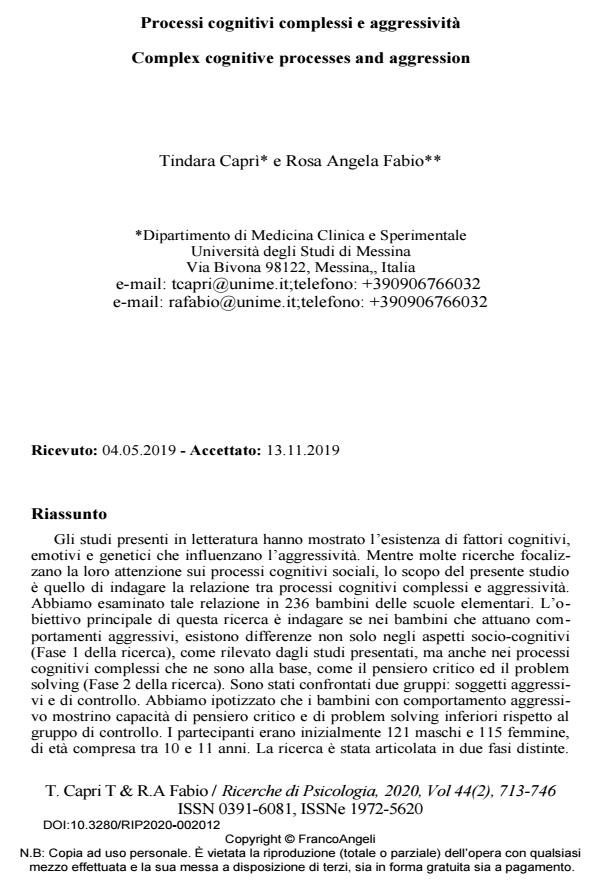Processi cognitivi complessi e aggressività
Titolo Rivista RICERCHE DI PSICOLOGIA
Autori/Curatori Tindara Caprì, Rosa Angela Fabio
Anno di pubblicazione 2020 Fascicolo 2020/2
Lingua Italiano Numero pagine 34 P. 713-746 Dimensione file 352 KB
DOI 10.3280/RIP2020-002012
Il DOI è il codice a barre della proprietà intellettuale: per saperne di più
clicca qui
Qui sotto puoi vedere in anteprima la prima pagina di questo articolo.
Se questo articolo ti interessa, lo puoi acquistare (e scaricare in formato pdf) seguendo le facili indicazioni per acquistare il download credit. Acquista Download Credits per scaricare questo Articolo in formato PDF

FrancoAngeli è membro della Publishers International Linking Association, Inc (PILA)associazione indipendente e non profit per facilitare (attraverso i servizi tecnologici implementati da CrossRef.org) l’accesso degli studiosi ai contenuti digitali nelle pubblicazioni professionali e scientifiche
Gli studi presenti in letteratura hanno mostrato l'esistenza di fattori cognitivi, emotivi e genetici che influenzano l'aggressività. Mentre molte ricerche focaliz-zano la loro attenzione sui processi cognitivi sociali, lo scopo del presente studio è quello di indagare la relazione tra processi cognitivi complessi e aggressività. Abbiamo esaminato tale relazione in 236 bambini delle scuole elementari. L’obiettivo principale di questa ricerca è indagare se nei bambini che attuano comportamenti aggressivi, esistono differenze non solo negli aspetti socio-cognitivi (Fase 1 della ricerca), come rilevato dagli studi presentati, ma anche nei processi cognitivi complessi che ne sono alla base, come il pensiero critico ed il problem solving (Fase 2 della ricerca). Sono stati confrontati due gruppi: soggetti aggressivi e di controllo. Abbiamo ipotizzato che i bambini con comportamento aggressivo mostrino capacità di pensiero critico e di problem solving inferiori ri-spetto al gruppo di controllo. I partecipanti erano inizialmente 121 maschi e 115 femmine, di età compresa tra 10 e 11 anni. La ricerca è stata articolata in due fasi distinte. Nella prima sono state somministrate tre scale di self report e una scala di nomina dei pari per valutare rispettivamente: il comportamento aggres-sivo, l’autoefficacia e il disimpegno morale; inoltre due scale sono state sommi-nistrate agli insegnanti per valutare i comportamenti aggressivi, disattentivi e ipe-rattivi dei bambini. Nella seconda fase, 31 bambini sono stati selezionati dal campione iniziale e suddivisi in due gruppi (aggressivo vs controllo). Il pensiero critico e le capacità di problem solving sono stati testati da cinque strumenti. I risultati mostrano un'interessante relazione tra comportamenti aggressivi e le di-mensioni analizzate e rivelano differenze significative tra bambini con compor-tamento aggressivo e gruppo di controllo solo nel pensiero critico, e non nelle ca-pacità di problem solving. I risulati sono stati discussi alla luce della teoria dell'elaborazione delle informazioni sociali, secondo cui le abilità sociali e cogni-tive giocano un ruolo chiave nell'influenzare il comportamento aggressivo.
Parole chiave:Processi cognitivi complessi, aggressività, cognizione, pensiero critico, problem solving.
Tindara Caprì, Rosa Angela Fabio, Processi cognitivi complessi e aggressività in "RICERCHE DI PSICOLOGIA " 2/2020, pp 713-746, DOI: 10.3280/RIP2020-002012